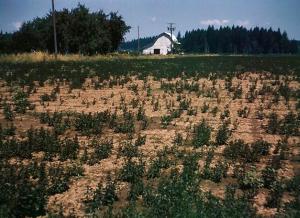|
||||
CONTENTS
[Return to Nematode Identification] |
Mint nematodes are migratory ectoparasites but differ from most nematodes in that the first stage juvenile hatches from the egg. The J1 emerge from eggs within a week and molt to J2 within the next week. Third stage juveniles (J3) appear during the third week, J4 during the fifth week and adults are present in the seventh week (Konicek, 1961). Mint nematode reproduce at soil temperatures as low as 50 F and perhaps lower. Most rapid population growth occurs at soil temperatures of 75-85 F but, as temperature increases above 85 F, reproduction declines. Few nematodes tolerate temperatures above 95 F. Reproduction tends to be slightly better in moist soils than in wet soils and the population is only able to subsist at low levels when soils become saturated. Feeding BehaviorMint nematodes feed exclusively on root tips, which are transformed into terminal galls in many plants. A cluster of empty cells around the stylet becomes progressively larger as feeding progresses. Holes develop in cell walls of the empty cells allowing cell contents from adjacent cells to flow through the empty cells towards the stylet (Sijmons et al., 1994) Symptoms and Effects on Plant GrowthDamage to peppermint may range from slight stunting to large barren areas. Symptoms are most evident during late spring and early summer before mint has a chance to cover (Konicek, 1961). Individual plants are generally shorter than comparable nematode-free plants and usually exhibit the reddish appearance often attributable to stress factors that retard mint growth. Roots are often malformed or stubby, and feeder roots may be absent. Nematodes probably do not kill the mint directly but rather the plants become unthrifty and die from an inability to take up sufficient water and nutrients. Stands thin over time, and there is reduced regrowth after harvest. Damaged areas often typically occur in localized areas or patches associated with nematode distribution (Pinkerton and Jensen, 1983). Top and root weights were reduced nearly 20% 90 days after infesting pots with 133 nematodes/quart soil (Jatala and Jensen, 1974). Similarly, plant growth was reduced 10 fold when cuttings were planted into infested field soil as opposed to steam-sterilized soil (Horner and Jensen, 1954). |

